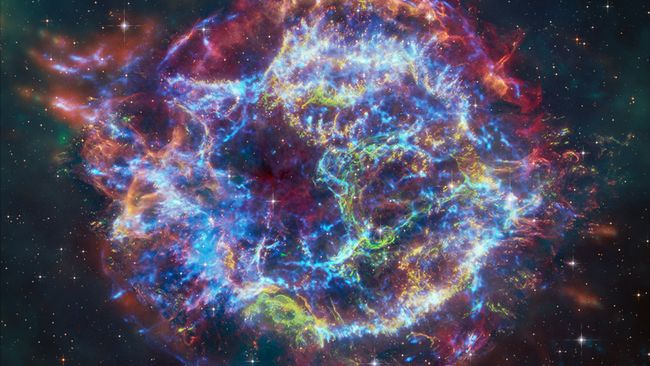Astronomers Unravel the Enigma of the ‘Green Monster’ within a Well-Known Supernova Remnant (Image)
This is the first time we have had the opportunity to observe an exploded star in such detail.
A recent study has revealed that the peculiar, Grinch-like wisp of green light known as the Green Monster, which was first observed last year weaving through the luminous remains of a supernova, is actually part of a blast wave surrounding the debris field. Last April, NASA’s James Webb Space Telescope (JWST or Webb) captured an image of this unusual “wall of emission” in front of Cassiopeia A (or Cas A), a shell of hot gas expanding approximately 11,000 light-years away from Earth. The light from Cas A reached us 340 years ago. Over the past year, astronomers have been attempting to unravel the origins and presence of this enigmatic phenomenon within the well-studied supernova remnant.
Presented on Monday (Jan. 8) at the American Astronomical Society conference in New Orleans and online, the new image showcases Cas A in unprecedented detail by combining the observational capabilities of Webb, as well as NASA’s Hubble, Spitzer, and Chandra space telescopes. The luminous sphere, spanning a distance of 10 light-years, appears to be infused with red clouds, indicating the presence of dust that has likely been warmed as it resides within gas heated to millions of degrees. Scattered throughout the image are streaks of white, green, and orange light, creating a visually captivating and chaotic depiction of the stellar debris.
Furthermore, serving as a valuable scientific resource, the photograph has brought astronomers one step closer to comprehending the origins of the enigmatic Green Monster. Recent observations indicate that its X-ray characteristics align with those of the outer regions of the supernova remnants, suggesting that this peculiar phenomenon was formed when a powerful blast wave collided with material that had already been expelled by the ill-fated star, between 10,000 and 100,000 years prior to its catastrophic explosion.
According to Ilse De Looze, a co-author of the study from Ghent University in Belgium, the Green Monster “is photobombing the central part of Cas A rather than being part of it.” In order to reveal the background, De Looze and her team digitally eliminated the Green Monster from the image. She likened this process to disassembling a completed 3D jigsaw puzzle to explore its internal components.
With the Green Monster effectively removed, the team gained access to a wealth of intricate details in the vicinity of the explosion’s epicenter, near the center of Cas A. Surprisingly, this area remained untouched by the subsequent shock wave, as explained by Danny Milisavljevic of Purdue University, the lead researcher of the new study.
Milisavljevic, while pointing to a black-and-white image on the screen depicting a delicate and intricate “web-like network” captured by the powerful infrared capabilities of the Webb telescope, exclaimed, “Here is the treasure map that we wanted.” He further emphasized that this is the first time scientists have been able to observe the inner workings of a supernova explosion with such remarkable preservation and detail.
The network of “pristine debris” likely formed when the star’s interior mixed with intensely hot radioactive matter during its collapse. Consequently, studying these structures can provide valuable insights into the physical processes involved in the collapse of the progenitor star, according to Milisavljevic.
However, as the team unraveled one enigma, they stumbled upon another. According to Milisavljevic, the ethereal green light seemed to be adorned with “remarkably circular cavities.” These captivating “cavities” might have materialized when clusters of supernova debris punctured through a dissipating cloud of stellar gas that had previously been shed by the celestial body.
“There are very few mechanisms in the vast expanse of the universe that can produce such perfectly round entities,” he remarked. “This particular explanation appears to be the most plausible.”
Subsequent investigations into the Green Monster and its enigmatic formations would provide astronomers with insights into the characteristics of the ill-fated star and its activities prior to its cataclysmic supernova explosion.
Do not forget to share your opinion with us to provide you with the best posts !




0 Comments